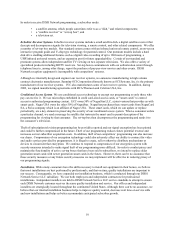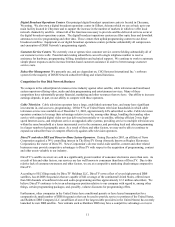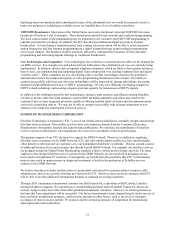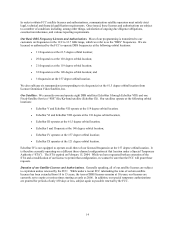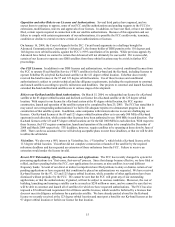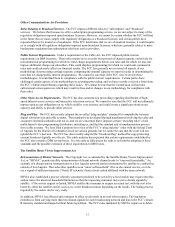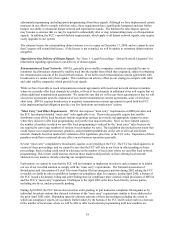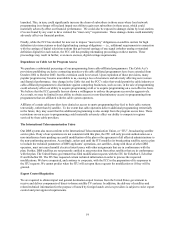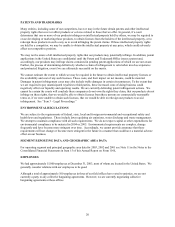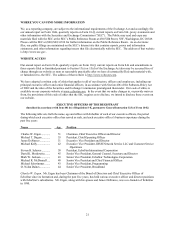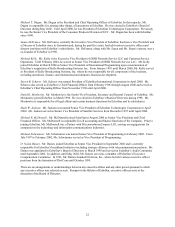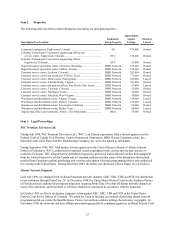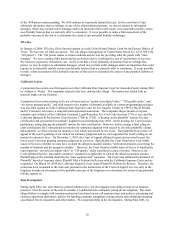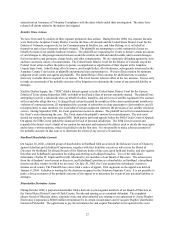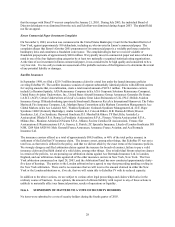Dish Network 2003 Annual Report Download - page 23
Download and view the complete annual report
Please find page 23 of the 2003 Dish Network annual report below. You can navigate through the pages in the report by either clicking on the pages listed below, or by using the keyword search tool below to find specific information within the annual report.18
substantial programming (including sports programming) from these signals. Although we have implemented certain
measures in our effort to comply with these rules, these requirements have significantly hampered and may further
hamper our ability to retransmit distant network and superstation signals. The burdens the rules impose upon us
may become so onerous that we may be required to substantially alter or stop retransmitting many or all superstation
signals. In addition, the FCC’s sports blackout requirements, which apply to all distant network signals, may require
costly upgrades to our system.
The statutory license for retransmitting distant stations is set to expire on December 31, 2004, and we cannot be sure
that Congress will extend that license. If the license is not extended, we will be unable to retransmit distant stations
altogether.
Opposition to Our Delivery of Distant Signals. See “Item 3 - Legal Proceedings – Distant Network Litigation” for
information regarding opposition to our delivery of distant signals.
Retransmission of Local Networks. SHVIA, generally gives satellite companies a statutory copyright license to
retransmit local broadcast channels by satellite back into the market from which they originated, subject to obtaining
the retransmission consent of the local network station. If we fail to reach retransmission consent agreements with
broadcasters we cannot carry their signals. This could have an adverse effect on our strategy to compete with cable
and other satellite companies, which provide local signals.
While we have been able to reach retransmission consent agreements with most local network stations in markets
where we currently offer local channels by satellite, roll-out of local channels in additional cities will require that we
obtain additional retransmission agreements. We cannot be sure that we will secure these agreements or that we will
secure new agreements upon the expiration of our current retransmission consent agreements, some of which are
short term. SHVIA requires broadcasters to negotiate retransmission consent agreements in good faith but FCC
rules implementing that obligation provide very few limitations on broadcasters’ actions.
“Must Carry” and Other Requirements. SHVIA also imposes “must carry” requirements on DBS providers and
the FCC has adopted detailed “must carry” rules applicable to us. These rules generally require that satellite
distributors carry all the local broadcast stations requesting carriage in a timely and appropriate manner in areas
where they choose to offer local programming, not just the four major networks. Since we have limited capacity,
the number of markets in which we can offer local programming is reduced by the “must carry” rules because we
are required to carry large numbers of stations in each market we serve. The legislation also includes provisions that
could expose us to material monetary penalties, and permanent prohibitions on the sale of all local and distant
network channels, based on inadvertent violations of the legislation, prior law, or the FCC rules. Imposition of these
penalties would have a material adverse effect on our business operations generally.
Several “must carry” complaints by broadcasters against us are pending at the FCC. The FCC has ruled against us in
certain of these proceedings, and we cannot be sure that the FCC will rule in our favor in other pending or future
proceedings. Such a ruling could result in a decrease in the number of local areas where we can offer local network
programming. This in turn could increase churn in those markets and preclude us from offering local network
channels in new markets, thereby reducing our competitiveness.
Furthermore, we cannot be sure that the FCC will not interpret or implement its rules in such a manner as to inhibit
our use of our two-dish solution to comply with the “must carry” requirements. The National Association of
Broadcasters and Association of Local Television Stations filed an emergency petition during 2002 asking the FCC
to modify or clarify its rules to prohibit or hamper our compliance plan. In response, during April 2002, a bureau of
the FCC issued a declaratory ruling and order finding that our compliance plan violated certain provisions of SHVIA
and the FCC’s “must carry” regulations. Challenges to the April 2002 order have been filed by various parties,
including one by us, and are presently pending.
During April 2002, the FCC bureau also issued an order granting in part numerous complaints filed against us by
individual broadcast stations that claimed violations of the “must carry” requirements similar to those addressed in
the prior April 2002 order. Depending upon the ultimate outcome of these proceedings (including the extent to
which our compliance reports are accepted), further orders by the bureau or the FCC itself could result in a decrease
in the number of local areas where we will be able to offer local network programming until new satellites are




